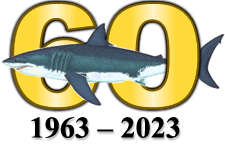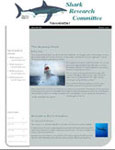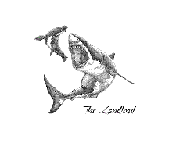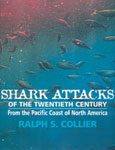|
Pacific Coast Shark News 2024The following reports for 2019 are provided as a public service. They are intended to inform our visitors of current shark activities along the Pacific Coast of North America. To review Pacific Coast Shark News for 2003 click here, for 2004 click here, for 2005 click here, for 2006 news click here, for 2007 click here, for 2008 click here, for 2009 news click here, for 2010 news click here, for 2011 news click here, for 2012 news click here, for 2013 click here, for 2014 click here, for 2015 click here, for 2016 click here, for 2017 click here, for 2018 click here, and for 2019 click here.
Pacific Coast Shark Attacks During 2023There were 3 authenticated unprovoked shark attacks reported from the Pacific Coast of North America during 2023, with one fatal. The 3 attacks were from California with no authenticated cases reported from Oregon or Washington. Distribution of the attacks by month were; August (1), October (2). There were no shark attacks reported from Southern California, with all 3 of the reported attacks north of Santa Barbara County. Activities of the victims were; Swimming 1, Kite Surfing 1 (Fatal), and Kayak 1. The Great White Shark, Carcharodon carcharias, was positively identified or highly suspect in all 3 of the attacks. The publication “Shark Attacks of the Twentieth Century” authenticated 108 unprovoked shark attacks from the Pacific Coast between 1900 and 1999. The Great White Shark was implicated in 94 (87%) of the 108 confirmed attacks with an annual average of slightly more than one shark attack per year. The 3 cases reported for 2023 brings the total number of unprovoked shark attacks occurring along the Pacific Coast during the 21st Century to 135. This is nearly ‘six times’ the Twentieth Century annual average of slightly more than one shark attack per year. The Great White Shark was positively identified or highly suspect in 123 (91%) of the 135 attacks recorded during the 21st Century. From 2000 to the present, 64 (47%) of the 135 confirmed shark attacks occurred during the three month period of August (20), September (15) and October (29). Victim activity for the 135 shark attacks reported from the Pacific Coast since 2000 are distributed in the following ocean user groups; surfing 75 (56%), kayaking 23 (17%), swimming 15 (11%), diving 9 (7%), paddleboarding 8 (6%), outrigger 2 (1%), windsurfing 1 (1%), fishing 1 (1%) and boogie boarding 1 (1%). There have been 243 authenticated unprovoked shark attacks reported from the Pacific Coast of North America from 1900 thru 2023. The Great White Shark was positively identified or highly suspect in 199 (82%) of the 243 cases. There were 8 fatal shark attacks confirmed from 1900 to 1999 and 8 fatal attacks reported from 2000 to 2023. The 16 fatal attacks represent 7% of the 243 total cases. The number of shark-bitten stranded marine mammals reported in 2023, including their locations, suggests a significant increase in the number of Great White Sharks utilizing those specific areas. However, the frequency of Great White Shark encounters and observations might also be attributable to population dynamics between humans, sharks, and prey species. The Shark Research Committee will continue to closely monitor these activities.
|
||||||||||||||||
|
|
|




